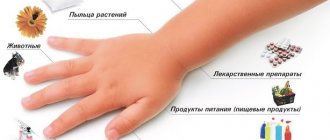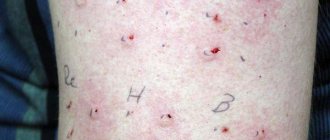- About the disease
- Year-round allergic rhinitis in children and adults
- Symptoms
- Diagnostics
- Treatment methods
- Precautionary measures
- Prevention
- Conclusion
Allergy - (from the Greek “foreign” and “exposure”) is a modern and, unfortunately, very common disease. Affecting people at different ages, it becomes a real test for a person. Especially when it comes to year-round allergies.
About the disease
If, after contact with an allergen, the nasal mucosa becomes inflamed, allergic rhinitis develops. If such contact occurs constantly, then year-round allergic rhinitis is diagnosed. The chronic course of the disease is often accompanied by various complications: asthma, sinusitis
, conjunctivitis, dermatitis.
Up to 20% of the world's population suffers from year-round allergic rhinitis. And this number is constantly increasing. The disease is more common among young people.
Year-round allergic rhinitis in children and adults
Year-round allergic rhinitis occurs in children and adults due to increased sensitivity to substances that have an irritating effect. They enter the body when inhaling air containing large amounts of such substances - allergens.
They can be associated with ticks, rodents, cats, dogs, birds, insects and other pets. Their fur and secretions cause a response in the body in the form of allergic rhinitis. Although this allergen is active on average for 20-30% of people, it is important to identify it as early as possible.
This type of rhinitis can also occur when fungi appear in the house or during prolonged professional activity associated with constant contact with an allergen.
The complexity of the patient's condition is sometimes aggravated by medicinal, food or seasonal allergens (pollen).
The forms of year-round allergic rhinitis are different. In a milder form, a runny nose appears and disappears along with other symptoms and lasts for 4 days. This form of rhinitis can recur up to 4 times in a year.
In the chronic form, symptoms are present almost the entire week, and there are more than 4 such weeks a year.
Year-round allergic rhinitis is a disease that seriously affects a person’s general condition. This is especially true for children.
Constantly inflamed nasal mucosa, a large volume of discharge, itching, sneezing can lead to ENT diseases: sinusitis, sinusitis, pharyngitis, tonsillitis and others. Frequent headaches affect the quality of sleep. The child becomes lethargic and has difficulty attending school or kindergarten.
Dark circles under the eyes and painfully irritated skin above the upper lip (the so-called “allergic face”) appear on the face.
In addition, allergic rhinitis can cause bronchial asthma.
Causes of allergic rhinitis
Treatments and medications are prescribed by a doctor after the allergen has been identified. You should not self-medicate, as this can lead to swelling and even anaphylactic shock.
In case of exacerbation of seasonal allergies, the following are prescribed:
- Drugs with antihistamine effect.
- Vasoconstrictor medications.
- Saline solutions.
There are two types of sources of allergies - open and closed.
Open sources are typical for seasonal manifestations of rhinitis, which often occurs in the initial stages during periods of flowering of trees (spring-summer) or wild grasses and shrubs (August-September). Open allergens include:
- Pollen;
- Herbs;
- Food;
- Mold.
Closed sources of rhinitis indicate a more serious form of the disease with its possible transition to the chronic stage. As a rule, closed allergens are not found in a single copy, but comprise entire groups of elements that cause an inflammatory reaction in the body. Closed allergens include:
- Pet hair;
- Dust mites;
- Tobacco smoke;
- Cosmetics;
- Cockroaches;
- Mold growing in damp areas.
The allergic nature of a runny nose can be caused by any element that you encounter during your daily activities. In nature, there are a huge number of allergens to which the body produces immunoglobulin E (IgE) antibodies, which play a major role in the occurrence of allergic reactions.
It is IgE that can play a cruel joke on you, perceiving familiar and previously safe products, substances or elements as foreign, causing an allergic reaction. In medical practice, such cases occur quite often, and determining the nature of the disease becomes an extremely difficult task.
The main cause of the disease is the massive release of pollen into the air by plants.
A person may have a negative reaction to a single plant, or to an entire family of grasses, trees, or other crops, or even to several different plants at the same time.
Pollen contains protein compounds, which are plant proteins. They are the main cause of allergic reactions in humans. They are so small that they are easily carried by the wind.
They can also be spread by animals and insects.
Factors that provoke the disease include:
- genetic predisposition;
- malfunction of the immune system;
- alcohol abuse;
- smoking;
- living in an environmentally polluted area;
- problems with the respiratory system;
- bronchial asthma;
- frequent colds.
This type of runny nose, unlike acute attacks of the disease, has a long, protracted course. If a person becomes allergic to a certain substance, in most cases it is accompanied by watery nasal discharge, which indicates the onset of vasomotor allergic rhinitis. It is non-infectious in nature, therefore it is not accompanied by elevated temperature, characteristic of colds.
For chronic vasomotor rhinitis, the allergic component may be a substance that enters the nasal sinuses from the outside or is formed in the body itself (for example, toxins or chemical components of antibiotics). In contrast to this type of runny nose, possible causes of chronic non-allergic rhinitis may be old forms of acute respiratory viral infections, pathological growths in the nasopharynx (polyps, adenoids) and such serious diseases as tuberculosis, whooping cough, measles, rubella.
Chronic allergic rhinitis is a sluggish form of the disease in which the body partially adapts to constant exposure to the allergen, but with a weakening of the immune system and an increase in the amount of irritating substances, relapses and violent outbreaks of an allergic reaction are possible.
This can lead to bronchial asthma and complicated forms of conjunctivitis. If it is impossible to eliminate the allergen, then it is important to carry out a timely course of treatment that reduces the severity of allergy symptoms. Desensitization produces a good effect - introducing small portions of the irritant subcutaneously, but the procedure is carried out only during the period of remission, and not all patients can achieve complete recovery.
The patient has an allergic reaction to irritants with pronounced properties: flowers with a strong aroma; tiny dust or chemical particles that easily penetrate into the nasal cavity with air; toxins that poison the body; products that have a sharp sweet or sour taste (citrus fruits, honey).
- some food products;
- dust mites, house dust;
- fluff with which pillows are stuffed;
- bird feathers and animal fur;
- mold, the formation of which begins in damp places that are not ventilated;
- harmful substances in the air at enterprises where coal dust, gas, and chemical particles are found in the atmosphere;
- flower pollen.
In addition to allergenic substances, harmful bacteria can enter the nasal cavity and begin to actively multiply, causing symptoms characteristic of an infectious runny nose.
It is important for doctors to differentiate the signs of the disease by thoroughly diagnosing the patient.
Symptoms
The symptoms of allergic rhinitis are basically the same in all its forms.
For seasonal rhinitis:
- The nasal mucosa swells, characteristic itching causes repeated sneezing, the discharge is more like water, the nose is stuffy; there are problems with the eyes - lacrimation, redness, swelling, bruises under the eyes; as the allergic process develops, the throat begins to sore, coughing, difficulty breathing and even wheezing in the lungs appear;
- Severe headaches, hives, problems with joints and intestines may bother you. In case of individual reactions - convulsions, fever, Quincke's edema;
- The weather affects the body: allergic reactions are stronger in hot, windy weather during the day and evening. The patient's condition is better at night and after rain.
With year-round rhinitis the following are characteristic:
- Constant nasal congestion due to characteristic inflammation of the mucous membrane, although patients complain less of itching and sneezing than with seasonal rhinitis;
- Mucous and thick nasal discharge;
- Increased fatigue due to headaches, poor sleep, complaints of itchy skin and decreased sense of smell.
What is the difference between year-round rhinitis and seasonal rhinitis?
Features of the course of rhinitis depend on the frequency of entry of the antigen into the body. If a person cannot tolerate the pollen of certain plants, allergy symptoms coincide with the period of their flowering.
In this situation, seasonal rhinitis is diagnosed. Since the flowering time of plants is different, there are several peaks of exacerbation of such a runny nose.
Year-round, or persistent, rhinitis occurs with constant or periodic exposure to an allergen. This form of pathology has nothing to do with exposure to pollen. Allergens are different. These include house dust, perfumes, animal food, dyeing compounds, and wool.
Year-round rhinitis is characterized by certain features. These include the following:
- Prolonged inflammation in the nose can lead to infection. It is accompanied by the appearance of purulent discharge, an increase in temperature, and a disturbance in general well-being.
- Constant swelling of the nasal mucosa leads to their hypertrophy. In such a situation, nasal congestion becomes permanent.
- Often, year-round rhinitis provokes damage to the organ of hearing. There is also a risk of deterioration of the sense of smell.
A common feature of seasonal and year-round rhinitis is the inhalation of the allergen into the body. These conditions are different types of the same disease.
Features of symptoms of year-round rhinitis:
Diagnostics
When diagnosing year-round allergic rhinitis, joint actions of an allergist and an ENT doctor are needed. This is especially important when treating children.
Heredity is taken into account in diagnosis. External signs of the patient - “allergic face” - will indicate the nature of the disease.
Examination of the nasal mucosa - rhinoscopy - using special instruments allows you to determine the condition of the nasal passages.
Tests are needed to determine the allergens responsible for the occurrence of rhinitis.
In special cases, a computed tomography (CT) scan is ordered to check for polyps or sinusitis.
Diagnosis of the disease
The severity of the disease is assessed by a specialist by collecting anamnesis, carefully studying the patient’s complaints and local examination. To make an accurate diagnosis and adequately select a treatment method, the doctor prescribes clinical and laboratory tests.
A clinical study is conducted to determine the level of hypersensitivity to certain allergens. Skin tests are used for research.
Laboratory testing is carried out to accurately determine the level and concentration of a specific allergen IgE in the blood serum.
Reliable and informative laboratory methods include:
- allergosorbent test RAST;
- radioimmunosorbent test PRIST.
The above methods allow you to identify certain types of allergens that cause allergic rhinitis all year round. Based on the identified allergens, complex treatment is prescribed. Information about which allergen causes an exacerbation allows the patient to exclude or reduce contact with it, which significantly facilitates the course of the disease and helps prevent re-exacerbation.
Treatment methods
At the beginning of treatment, it is necessary to ensure that there is no contact with the allergen. If these are pets, it is necessary to exclude communication with them. If you are allergic to house dust, then you should stop using carpets and make regular daily wet cleaning.
If a food allergen is identified, it is important to follow a special diet. In combination with seasonal allergies, try to spend less time in places where plants bloom, keep windows closed, and take advantage of trips to another region.
During treatment, nasal lavages (saline solution, sea water Sialor Aqua
) help well.
Antihistamines are prescribed only by the attending physician.
He also determines how to administer the drugs: orally or irrigate the mucous membrane.
When prescribing hormones, it is more convenient to use the medications topically: in the form of a spray or drops.
With the development of allergic rhinitis, a lot of mucus is released, which flows down the back wall of the larynx. This can lead to spasms and make it difficult for the body to clear mucus. Expectorants are prescribed for treatment.
Physiotherapeutic procedures are mandatory. Selected individually, they will help quickly restore the nasal mucosa and remove the negative effects of allergens.
Prevention
Preventive measures in case of allergic rhinitis are general.
- Lead a healthy lifestyle.
- Cultivate a healthy diet.
- Strengthen immunity.
- Stop the allergen from entering the body.
- Undergo regular preventative treatment.
Preventive treatment consists of introducing small doses of the allergen into the body to obtain an addictive reaction.
Read how to properly treat allergic rhinitis with folk remedies here.
Doctors advise following the recommendations:
- Humidify dry indoor air. If there are no special devices, it is enough to place wet towels in the room or place several containers with water.
- Regularly wipe dust from furniture. There is a simple way to clean upholstery: cover with a damp, light-colored sheet and pat. All dust will remain on the fabric.
- Plan a menu of healthy, simple foods, and not of unfamiliar products, especially canned ones.
- Regularly spend time in the fresh air, take walks, and play sports.
- Hardening procedures are of great importance: rubbing, dousing first with warm and then cold water.
These simple tips will help avoid relapses of chronic allergic rhinitis and reduce alarming symptoms. Whether the patient recovers or not depends primarily on him.
For drug prevention of rhinitis in children and adults, drugs containing cromones are used:
- Cromohexal;
- Cromosol;
- Cromoghlin.
The drugs help reduce the symptoms of the body's reaction to the allergen. The drugs have an extremely positive effect on the course of the disease, also helping to prevent it.
There are other methods for preventing the development of nasal congestion and the formation of allergic rhinitis, including:
- Replacing bed linen, pillows and blankets with new ones with anti-allergenic filling;
- 3 times comprehensive cleaning of the apartment per week;
- No pets in the apartment;
- Changing your place of residence to another region during an exacerbation of an allergic reaction.
Properly selected therapy and a combination of various methods of treating hay fever significantly reduces the negative symptoms of hay fever. If a child suffers from it, in 90% of cases the disease disappears by adolescence. https://medic.land/allergiya/simptomy/dyhatelnaya-sistema/nos/zalozhennost-n/lechenie/lekarstva/lekar.html
We must not forget that there are serious forms of diseases that require more thorough diagnosis, treatment of nasal congestion and preventive measures.
The patient must:
- quit smoking;
- during flowering of grasses and trees, avoid walking in parks, forests, public gardens;
- use household chemicals with caution;
- after walking outside, take a shower, wash your face and hands;
- regularly rinse the nasal mucosa with saline solutions;
- remove carpets and soft toys from the apartment;
- close windows during seasonal flowering of plants;
- carry out wet cleaning regularly;
- pillows and blankets should be made of padding polyester or bamboo;
- It is better to dry laundry or clothes indoors;
- close the window at night. The maximum concentration of pollen in the air is a windless morning. On the contrary, the best time for ventilation is after rain.











